Armed Forces of Montenegro
 From Wikipedia - Reading time: 18 min
From Wikipedia - Reading time: 18 min
| Armed Forces of Montenegro | |
|---|---|
| Војска Црне Горе (Montenegrin) | |
 | |
 Flag of the Armed Forces of Montenegro | |
| Motto | Čojstvo i Junaštvo (cnr) Humanity and Bravery (en) |
| Founded | 1879 |
| Current form | 2006 |
| Service branches | |
| Headquarters | Podgorica |
| Website | www |
| Leadership | |
| Commander-in-chief | |
| Minister of Defence | Dragan Krapović |
| Chief of the General Staff | Zoran Lazarević |
| Personnel | |
| Military age | 18 years of age |
| Conscription | No |
| Fit for military service | 184,159 males, age 15–49, 171,823 females, age 15–49 |
| Active personnel | 2,350[1] |
| Expenditure | |
| Budget | €134 million |
| Percent of GDP | 1.9% 2024 |
| Industry | |
| Domestic suppliers | TARA Aerospace and Defence Products AD |
| Foreign suppliers | |
| Related articles | |
| History | Military history of Montenegro |
| Ranks | Military ranks of Montenegro |
The Armed Forces of Montenegro (Montenegrin: Војска Црне Горе, romanized: Vojska Crne Gore) are the military forces of Montenegro. The Armed Forces consists of an army, navy and air force.
The military currently maintains a force of 2,350 active duty members.[1] The bulk of its equipment and forces were inherited from the Armed Forces of Serbia and Montenegro; as Montenegro contained the entire coastline of the former union, it retained the entire naval force.[citation needed]
On 5 June 2017, Montenegro joined NATO as the 29th member.
Command
[edit]Leadership
[edit]- Commander in Chief President Jakov Milatović
Ministry of Defence
[edit]- Minister of Defence, Dragan Krapović
- Chief of General Staff Brigadier General, Zoran Lazarević
Bases
[edit]Air Bases
[edit]Naval Bases
[edit]- Bar Naval Base
- Pero Ćetković Base
- Pristan Base
Army Bases
[edit]- Milovan Šaranović Army Base
- Nikšić Army Base
- V. K. Volođa Army Base
- Breza Army Base
- Masline Army Base
- Аndrijevica Army Base
Units and structure
[edit]
 General Staff, in Podgorica[3]
General Staff, in Podgorica[3]
 1st Infantry Battalion, in Danilovgrad
1st Infantry Battalion, in Danilovgrad
- 1st Infantry Company, in Nikšić
- 2nd Infantry Company, in Pljevlja
- 3nd Infantry Company, in Andrijevica
- Mountain Infantry Company, in Kolašin
- Fire Support Company, in Podgorica
- Signal Platoon, in Danilovgrad
- NBC Defence Platoon, in Danilovgrad
- Service Section, in Danilovgrad
 Air Force, at Podgorica Airbase
Air Force, at Podgorica Airbase
- Flying Squadron
- Air Surveillance & Reporting Centre, in Golubovci, reports to NATO's Integrated Air Defense System CAOC Torrejón in Spain
- Support Company
- Signal Platoon
- 1st Air-Defence Platoon
- 2nd Air-Defence Platoon
- Service Section
 Navy, in Bar
Navy, in Bar
- Patrol Boat P105
- Patrol Boat P106
- Coastal Surveillance Company
- Training Ship "Jadran"
- Auxiliary Boats Detachment
- Support Company, in Danilovgrad
- Combat Support Battalion, in Podgorica
 Special Forces Company
Special Forces Company- Marine Detachment
 Military Police Company
Military Police Company Honorary Guard Company
Honorary Guard Company
- Support Battalion, in Danilovgrad
- Engineer Company
- Maintenance Company
- Mixed Logistic Company
- Warehouse Platoon
- Logistic Platoon
- 2nd Infantry Battalion (Reserve), in Pljevlja
- 3rd Infantry Battalion (Reserve), in Andrijevica
- Mixed Artillery Battalion (Reserve), in Nikšić
- Training Center, in Danilovgrad
- Medical Center, in Podgorica
- Signal and Electronic Warfare Company, in Podgorica
Ranks and insignia
[edit]The military before 1918
[edit]
After military successes in the wars 1876–1878 during which the Principality of Montenegro was enlarged by a large territory, from the Tara River in the north to the Adriatic Sea in the south (liberated towns Podgorica, Nikšić, Kolašin, Andrijevica, Bar and Ulcinj), reorganization in Montenegrin army was conducted in 1880. Each kapetanija (municipality) formed its reserve battalion. There were 42 battalions in total. Since 1881, regular military exercises were conducted.
Supreme Commander of the Montenegrin army was the monarch, Prince / King Nikola I. Operational command, organization and financial support of the Montenegrin army was entrusted to the Ministry of Defence, the department of the Government of the Principality / Kingdom of Montenegro.
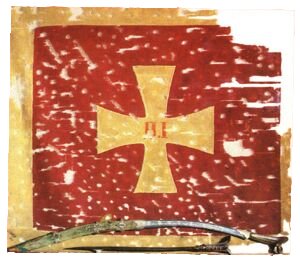
General Staff of the Montenegrin army was part of the Ministry of Defence.
In 1882 first 14 Montenegrins were sent to officer schools abroad, particularly in Italy and Russia. In 1886, 10 of them completed their education and they become first trained officers in Montenegrin warrior history. These Montenegrin officers held courses in Podgorica, Nikšić and Cetinje.
In September 1895, the first permanent Infantry NCO school in Podgorica was opened, and the first NCOs got desečar rank. At the end of 1896, artillery officer school in Cetinje was established – the first Montenegrin officer school.
Formations
[edit]
In 1906 Montenegrin army received the first systematized regulations, and the Law on Organization of the Army was adopted in 1910. Infantry and artillery, were established, followed by two specialized branches (reconnaissance and pioneering), and additional branches (medics, military workshop, the military court staff, gendarmerie and logistics).
In 1913 the Montenegrin gendarmerie became a special Military Police unit.
Since the establishment of the internal Montenegrin telecommunications system in 1869, vital for the flow of military-defence information, it was under the jurisdiction of Ministry of the military.
Until 1912, the territory of the Kingdom of Montenegro was divided into four divisional areas:
- 1.Cetinje divisional area
- 2.Podgorica divisional area
- 3.Nikšić divisional area
- 4.Kolašin divisional area
After wars 1912th–1913th established additional two divisions field:
By 1912, the Montenegrin Army had 11 brigade areas, 52 districts and 322 battalion troop areas. Divisions were composed of 2–3 Infantry Brigade.
Each divisional command had three artillery batteries. On the eve of the First Balkan War Kingdom of Montenegro lined up 55,000 soldiers.
After the establishment of the Kingdom of Montenegro in 1910, Montenegro was involved in three wars with the first one being the First Balkan War, in alliance with Serbia, Greece, Romania, and Bulgaria against the Ottoman Empire. The Second Balkan War was fought between Montenegro, Serbia, Greece, Romania and the Ottoman Empire against Bulgaria, with Bulgaria consequently losing significant territory in the north, Thrace, and Macedonia.
The Military of Montenegro before 1918, was much larger than today's military. During World War I, Montenegro mobilised 50,000 troops. The Commander-in-Chief was King Nikola I of Montenegro, while the General of Staff was Božidar Janković. Units included:
- Pljevlja Division
The Pljevlja Division was commanded by Brigadier Luka Gojnić. The division was made up of 10 battalions. It had around 6,000 soldiers and patrolled the area east from Pljevlja.
- Herzegovina Detachment
The Herzegovina Detachment was commanded by Serdar (Count) Janko Vukotić. The detachment was made up of 15 battalions. It had around 15,000 soldiers, and patrolled the border with Herzegovina.
- Lovćen Detachment
The Lovćen Detachment was commanded by divizijar Mitar Martinović. The detachment was made up of 18 battalions. It had around 8,000 soldiers, and patrolled the areas of Lovćen and Sutorman.
- Old Serbia' Detachment
The 'Old Serbia' Detachment was commanded by Brigadier Radomir Vešović. The detachment was made up of 13 battalions. It had around 6,000 soldiers and secured the Albanian border.
Uniforms
[edit]Most soldiers of the Montenegrin army had no uniforms. At mobilization, the soldiers were issued with a rifle and a badge to put on the cap. Both soldiers and officers in the reserve wore national costume. The badges in the caps had different designs depending on the rank of the wearer.


Ranks and Badges
[edit]All Montenegrins between 18 and 62 years were conscripts. Recruitment was done three times a year, and the recruits are in peacetime had to have at least 25 years.
- Officer ranks were: potporučnik, poručnik, kapetan, komandir, brigadir, divizijar
- NCO ranks were: desečar, donarednik, narednik
- Ceremonial ranks were: serdar, vojvoda
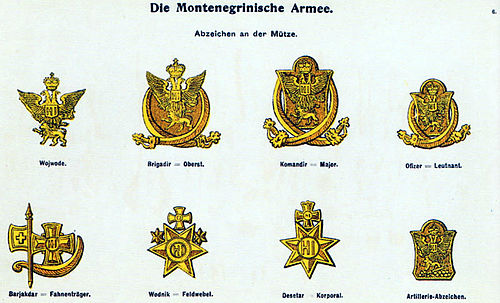
Peacekeeping operations
[edit]Montenegro participates in peace operations under the NATO and UN auspices as military troops and observers. Minister of Defense said that 85 soldiers are trained for international missions.[4] Montenegrin soldiers are trained by the German Bundeswehr.[5]
Montenegro sent 45 troops and medical personnel to the ISAF mission in Afghanistan and later took part in the Resolute Support Mission.[6][7]
Montenegro also participates in UN peacekeeping missions in Liberia, UNMIL, Cyprus, UNFICYP as military observers and Somalia, EU-NAVFOR.[8]
| Current Mission | Organization | Country | Nr. of personnel |
|---|---|---|---|
| NATO EFP | NATO | Latvia | Special forces team |
| KFOR | NATO | Kosovo | 2 Officers |
| UNMIL | UN | Liberia | Officers as military observers |
| UNFICYP | UN | Cyprus | Officers as military observers |
| MINURSO | UN | Western Sahara | Officers as military observers |
| EU-NAVFOR | EU | Somalia | 12 Members (APVD team)[9] |
| EUTM Mali | EU | Mali | Officers training |
Equipment
[edit]Ground Army
[edit]| Weapon | Country manufactured | Cartridge | Quantity | Pictures | Notes | |||
|---|---|---|---|---|---|---|---|---|
| Pistols | ||||||||
| Glock 17[10] | 9×19mm Parabellum | 
|
Standard gun of Montenegrin Military.[11] | |||||
| Zastava CZ99 | 9×19mm Parabellum | 
|
Standard gun of Montenegrin Military | |||||
| Tara TM9 | 9×19mm Parabellum | 
|
Currently in use. | |||||
| Submachine guns | ||||||||
| Heckler & Koch MP5 | 9×19mm Parabellum | 
|
Used by Special Forces.[12][13] | |||||
| Tara TM-9 | 9×19mm Parabellum | Similar to the Colt 9mm SMG, but with forward assist and Glock magazine compatibility.[14] | ||||||
| Assault rifles | ||||||||
| Zastava M59/66 | 7.62×39mm | Ceremonial rifle | ||||||
| MPT-76 MPT-55 |
7.62×51mm NATO 5.56×45mm NATO |
30 | 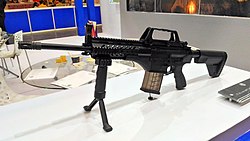
|
15 × rifles in NATO calibre 7.62×51mm and 15 × rifles in 5.56×45mm NATO ammunition according to a protocol signed by representatives of the Turkish and Montenegrin defence ministries in Ankara on 1 October 2019.[15] | ||||
| Heckler & Koch G36 | 5.56×45mm NATO | 655 (as of 2015)[16] |
Standard rifle of Montenegrin Military | |||||
| Steyr AUG | 5.56×45mm NATO | 
|
Used by Special Forces | |||||
| Heckler & Koch HK416 | 5.56×45mm NATO | 
|
Used by Special Forces.[12][17] | |||||
| Tara TM4 | 5.56×45mm NATO | Standard issue rifle in the Montenegrin ground army | ||||||
| Zastava M70/M70A | 7.62×39mm | 
|
In reserve | |||||
| Sniper rifles | ||||||||
| Heckler & Koch PSG1 | 7.62×51mm NATO | 
|
PSG 1 and MSG 90 in service.[18][19] | |||||
| Zastava M93 Black Arrow | 12.7×108mm | 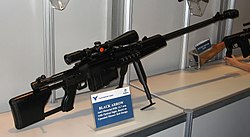
|
In service | |||||
| Zastava M76 | 7.92×57mm Mauser | 
|
In reserve | |||||
| Zastava M91 | 7.62×54mmR | 
|
In reserve | |||||
| Machine guns | ||||||||
| Zastava M84 | 7.62×54mmR | 
|
In service.[12] | |||||
| Zastava M72 | 7.62×39mm | 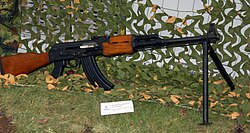
|
In reserve | |||||
| Grenade launcher | ||||||||
| BGA 30mm | 30×29mm | 
|
In service | |||||
| Heckler & Koch AG36 | 40×46mm | 
|
In service | |||||
| Anti-tank | ||||||||
| M79 Osa | 90 mm rocket | 
|
In service, planned to buy new man-portable anti-tank systems.[citation needed] | |||||
| M80 Zolja | 64 mm rocket | 
|
In service, planned to buy new man-portable anti-tank systems.[citation needed] | |||||
| 9M14 Malyutka | 64 mm rocket | 
|
In service | |||||
| Mortar | ||||||||
| M57 | 60 mm | 43 | 
|
In service | ||||
| M69 | 82 mm | 44 | 
|
14 active, 30 in reserve | ||||
| M74/M75 | 120 mm | 32 | 
|
In service.[20] | ||||
| Howitzer | ||||||||
| D-30J 122 mm | 122 mm | 12 | 
|
In service.[20] | ||||
| Multiple rocket launchers | ||||||||
| M-94 Plamen-S | 128 mm | 18 | 
|
In service.[20] | ||||
| Armoured personnel carriers | ||||||||
| model | country of origin | year of production | quantity | picture | notes | |||
| Oshkosh L-ATV | 2020 to 2024 | 67+? | 
|
The Gale Banks Engineering diesel engine develops 340 hp, gross vehicle mass (GVM) are 10.2 t, of which the payload is 3.8 t.
- 55 vehicles are equipped with Elbit Systems RCWS (Remote Controlled Weapon Station) with a 12.7 mm heavy machine gun - 4 vehicles are equipped with Rafael Samson RCWS armed with M230LF 30 mm lightweight automatic chain gun, - 4 vehicles are equipped with missile launchers for Spike LR HEAT and Spike SR missiles - 4 vehicles are command and reconnaissance vehicle - In May 2023 Montenegrin MoD signed a 22 million USD contract with Elbit Systems for a purchase of an unspecified number of 120 mm SPEAR Mk2 mortar systems to be mounted on JLTVs.[21] | ||||
| ACS LAPV 5.4 Enok | 2018 | 6 |  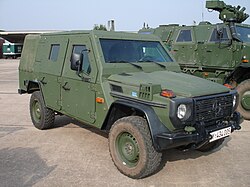
|
The diesel engine develops 184 hp, gross vehicle mass (GVM) are 5.4 t. | ||||
| Otokar Cobra | 2016 | 1 | 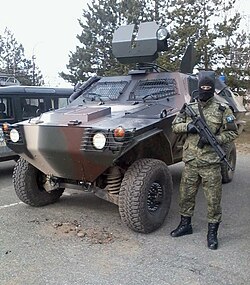
|
The diesel engine develops 190 hp, gross vehicle mass (GVM) are 6.7 t. Light armoured combat vehicle for chemical, biological, radiological and nuclear reconnaissance. | ||||
| Achleitner RCV Survivor | 2010 | 4 |  
|
The diesel engine develops 286 hp and 650 Nm, gross vehicle mass (GVM) are 8 t, of which the payload is 2.5 t. Reconnaissance and Command Vehicle (RCV) have modified chassis of the Toyota Land Cruiser 200. | ||||
| TAM BOV VP М86 | 3 | 
|
The diesel engine develops 150 hp and 490 Nm, gross vehicle mass (GVM) are 9.1 t. | |||||
| Military light utility vehicle | ||||||||
| Toyota Hilux RC 19 2.4 D 4x4 | 2020 | 20 | 
|
The diesel engine develops 150 hp and 400 Nm, gross vehicle mass (GVM) are 3 t, of which the payload is circa 1 t. | ||||
| Mercedes-Benz G-Class[22] | 2016 | 6 | 
|
The 3.0 V6 diesel engine develops 240 hp and 600 Nm | ||||
| Toyota Land Cruiser | 2016 | 1 | Ambulance vehicle | |||||
| Isuzu D-Max | 2016 | 1 | The diesel engine develops 163 hp and 400 Nm, and is used for food transport. | |||||
| Achleitner MMV Survivor | 2010 | 16 | 
|
The diesel engine develops 173 hp and 410 Nm, gross vehicle mass (GVM) are 4 t, of which the payload is circa 0.8 t. Militarized Mission Vehicle (MMV) is Toyota Land Cruiser but with reinforced suspension, additional engine and gearbox protection, modified brake system and the intake and exhaust system (so that the vehicle could go through water), can cary five soldiers and in the trunk there are five boxes for automatic rifles (one for each soldier) and painted in military color. | ||||
| Pinzgauer 710 | 
|
The petrol engine develops 90 hp and 185 Nm, gross vehicle mass (GVM) are 2,9 t, of which the payload is circa 1 t. | ||||||
| Military utility trucks | ||||||||
| BMC 245-16P | 2023 | 2 | The Cummins 615Be 245 diesel engine develops 245 hp and 925 Nm, gross vehicle mass (GVM) are 16 t, of which the payload is 8.5 t (off-road 5 t). | |||||
| BMC 380-26P | 2023 | 1 | The Cummins ISMe 385 30 diesel engine develops 380 hp and 1,834 Nm, gross vehicle mass (GVM) are 26 t, of which the payload is 15.5 t (off-road 10 t). | |||||
| Iveco MUV | 2019 | 1 | Ambulance vehicle | |||||
| Mercedes-Benz Unimog 405 | 2010 | 
|
||||||
| TAM 110 T7 B/BV | 
|
The F4 L 413 R diesel engine develops 115 hp and 350 Nm, gross vehicle mass (GVM) are 7 t, of which the payload is 2.5 t (off-road 1.5 t). | ||||||
| TAM 150 T11 B/BV | 
|
The F6 L 413 R diesel engine develops 150 hp and 490 Nm, gross vehicle mass (GVM) are 11.4 t, of which the payload is 5 t (off-road 3 t). | ||||||
| FAP 2026 | 
|
The OM 402 diesel engine develops 256 hp and 834 Nm, gross vehicle mass (GVM) are 21 t, of which the payload is 10 t (off-road 6 t). | ||||||
| Engineering vehicles | ||||||||
| IMK TG-110 IMK TG-140 IMK TG-160 IMK TG-190 IMK TG-220 |

|
Tracked bulldozer | ||||||
| IMK ULT-160 | 
|
Wheeled bulldozer | ||||||
| CAT 434F | 
|
Backhoe loader | ||||||
Navy
[edit]| Class | Country manufactured | Variants | Quantity | Pictures | Notes | |||
|---|---|---|---|---|---|---|---|---|
| Frigate | ||||||||
| Kotor class | – P-33 Kotor - P-34 Novi Sad |
1 1 |

|
2 in reserve[23] | ||||
| Fast attack craft | ||||||||
| Končar class | – RTOP-405 Jordan Nikolov Orce – RTOP-406 Ante Banina |
1 1 |

|
Under reconstruction. The ship RTOP-405 rentered service in 2019. under name P-105 "Durmitor".[citation needed] | ||||
| Transport and support | ||||||||
| PO class | – PO91 | 1 | 1 in reserve | |||||
| Tugboats | ||||||||
| Salvage tug | – PR-41 (Orada) - LR-77 |
1 1 |

|
2 in active service | ||||
| Sailing ship | ||||||||
| Jadran | Used as a training ship | 1 | 
|
1 in active service | ||||
| Motor sailboat | – Bojana - Milena |
1 1 |

|
2 in active service | ||||
| Motorboat | ||||||||
| Diving boat | -Ronilačka baraksa 81 -Ronilačka barkasa 85 |
1 1 |

|
2 in active service | ||||
| Motor boat Polycat | 1 | 1 in active service | ||||||
| Motor boat | – ČM 33 | 1 | 1 in active service | |||||
| Inflatable boat | ||||||||
| Valiant 620PT | Used by Marine Platoon | 2 | 
|
2 in active service | ||||
| Motor yacht | ||||||||
| Jadranka | VIP Yacht | 1 | 
|
Offered for sale | ||||
| Crane vessel | ||||||||
| Floating Crane | LDI 18 | 1 | 
|
1 in active service | ||||
Air Force
[edit]| Aircraft | Country manufactured | Variant | Quantity | Pictures | Notes | |||
|---|---|---|---|---|---|---|---|---|
| Transport | ||||||||
| Cessna 421 Golden Eagle | Cessna 421B Golden Eagle | 1 | 
|
One for transport, medical evacuation and training.[citation needed] | ||||
| Transport and utility helicopters | ||||||||
| SOKO Gazelle | SA-341H HO-42 SA-341H HI-42 SA-342L HO-45 SA-342L HN-45M |
4 1 2 4 |

|
not in use from 2020 | ||||
| Bell 412 | 412EP 412EPI |
1 2 |

|
One EP variant and two EPI variants. Medical evacuation, search and rescue, aerial firefighting, patrol.[24][25] | ||||
| Training helicopters | ||||||||
| Bell 505 Jet Ranger X | Bell 505 Jet Ranger X | 2 | 
|
Two for pilot training.[26] | ||||
| Air defence | ||||||||
| 9K32 Strela-2M | Portable low-altitude surface-to-air missile | Planned to buy new man-portable air-defense systems.[citation needed] | ||||||
| Bofors 40 mm Automatic Gun L/70 | Autocannon 40mm L/70, works with GIRAFFE Radar |
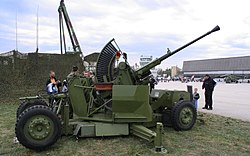
|
Planned for modernization.[citation needed] | |||||
| Giraffe radar | Early warning radar, works with Bofors 40mm L/70 |

|
Planned for modernization.[citation needed] | |||||
Gallery
[edit]-
Members of Special Forces Brigade
-
Members of Marine Detachment
-
Special forces
-
Montenegrin troops in Afghanistan
-
Montenegrin troops in Afghanistan
-
Infantry Company
-
Infantry Company
-
Sniper
-
Achleitner RCV Survivor
-
BOV M86
-
Combat drill
-
Soldier
-
NBC Defence
-
Military Police
-
Montenegrin navy boat
-
Montenegrin soldier holding a HK MP5
-
Kotor class Frigate
See also
[edit]References
[edit]- ^ a b International Institute for Strategic Studies (25 February 2021). The Military Balance 2021. London: Routledge. p. 126. ISBN 9781032012278.
- ^ "Where does Montenegro import Arms and ammunition". 14 November 2022. Retrieved 14 November 2022.
- ^ "Predlog odluke o organizacijsko - formacijskoj strukturi i veličini Vojske Crne Gore".
- ^ "Spremaju se za Avganistan". Archived from the original on 25 July 2011.
- ^ David Noack: Subsidiary Troops (German: Hilfstruppen), german-foreign-policy.com, 17.03.2008.
- ^ "Kasarna Danilovgrad: Svečanost za vojnike koji idu u Avganistan". Archived from the original on 8 March 2010.
- ^ "Rujović: Vojnici će opravdati očekivanja u misiji "Odlučna podrška" - Cafe del Montenegro". Archived from the original on 22 December 2015. Retrieved 12 December 2015.
- ^ "Vojska Crne Gore u međunarodnim misijama i operacijama". Archived from the original on 7 May 2021. Retrieved 3 June 2019.
- ^ "Crnogorci brane "Esbjerg" od pirata".
- ^ http://www.gov.me/files/1256832119.pdf Page 15
- ^ "PIŠTOLJ – GLOCK 17". www.vojska.me. Archived from the original on 4 February 2021. Retrieved 14 September 2018.
- ^ a b c "Specijalci bez greške i na 40 °C". www.rtcg.me (in Montenegrin). 23 July 2015.
- ^ "AUTOMAT HECKLER AND KOCH – MP5". www.vojska.me. Archived from the original on 3 February 2021. Retrieved 14 September 2018.
- ^ Popenker, Maxim (25 November 2017). "TARA TM-9 SMG submachine gun (Montenegro)". Modern Firearms.
- ^ DFNS. "Turkey gifts MPT rifles to Montenegro". DFNS.net Land. Archived from the original on 14 May 2020. Retrieved 14 November 2019.
- ^ "Schriftliche Fragen an die Bundesregierung im Monat Januar 2015; Frage Nr. 195" (PDF) (in German).
- ^ "HECKLER AND KOCH – HK 416". www.vojska.me. Archived from the original on 5 February 2021. Retrieved 14 September 2018.
- ^ "POLUAUTOMATSKA SNAJPERSKA PUŠKA PSG 1". www.vojska.me. Archived from the original on 16 May 2020. Retrieved 14 September 2018.
- ^ "HECKLER AND KOCH MSG 90". www.vojska.me. Archived from the original on 31 January 2021. Retrieved 14 September 2018.
- ^ a b c International Institute for Strategic Studies (14 February 2017). The Military Balance 2017. Vol. 117 (1 ed.). London, United Kingdom: Routledge. p. 138. ISBN 978-1857439007.
- ^ "The wars also affect the pace of equipping the Army of Montenegro: the Americans are late, but not the Israelis". vijesti.me. 14 January 2024. Archived from the original on 30 January 2024.
- ^ Montenegro army land ground armed forces military equipment armored vehicle intelligence pictures – Army Recognition
- ^ "Crna Gora prodaje "Kotor" i "Pulu"".
- ^ Bozinovski, Igor (5 February 2018). "Montenegro orders three Bell 412 helicopters". IHS Jane's 360. Skopje. Archived from the original on 5 February 2018. Retrieved 7 February 2018.
- ^ Zuvela, Maja; Sekularac, Ivana; Potter, Mark (30 January 2018). "Montenegro inks deal to buy three helicopters from Bell Helicopter". Reuters. Sarajevo. Archived from the original on 7 February 2018. Retrieved 7 February 2018.
- ^ "Montenegro Air Force adding two Canadian-built Bell 505s". 10 June 2020.
External links
[edit]- Official Website (Montenegrin)
- Montenegro in NATO (Montenegrin)
- "Europe’s Newest State Trims the Army" (DefenseNews.com)[dead link]
- "Appointment of the Acting Chief of the General Staff of the Army of Montenegro" (Website of the President of Montenegro)
- Montenegrin Armed Forces / Vojska Crne Gore – VCG
- Perspective of the Military of Montenegro, in English
- Montenegrin Armed Forces before 1918 / Vojska Crne Gore prije 1918
- Debate on NATO in Montenegro
- Milo Đukanović appoints himself as Minister of Defense
- / Forum article about Montenegrin military (in Serbian)
 KSF
KSF















